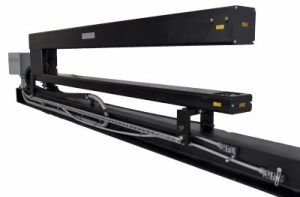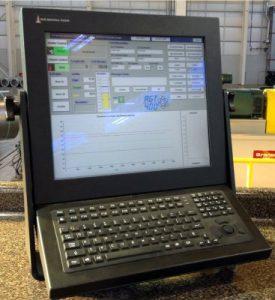John Fearing, our Senior Field Technician, completed the startup this week of a new AGT400 at MISA – National Metal Processing, S.A. de C.V. in Guanajuato, Mexico. This gauge, located on a 72” Braner Slitter, is an upgrade to an obsolete Gamma Ray GR200. It is MISA’s second AGT400 at this location and their fifth overall.
FEROLETO STEEL ORDERS TWO AGT800 LASER GAUGES
Feroleto Steel Co., Inc. recently placed an order for two AGT800 Laser Thickness Gauges. One gauge will be shipping to Feroleto’s Bridgeport, CT service center and the other is going to their Weirton, WV facility. Both gauges will be used on Loopco Slitters.
Feroleto selected the AGT800 Laser gauge in lieu of x-ray gauges after doing an extensive comparison of both technologies. This research included a visit to A.G.T. earlier this year by Glenn Valentine (Feroleto-Knoxville) who has taken the lead role in coordinating this project for the company.
A.G.T. Names Chinese Sales Representative
Advanced Gauging Technologies is pleased to introduce Shanghai CMS Automation Equipment Co., Ltd. as our new sales representative in China. Mr. Lin Zhang (Roger) will be our primary contact for all sales and marketing activities throughout the country. Please feel free to contact him for product information, literature and requests for quotes.
Shanghai CMS Automation Equipment Co., Ltd
Room 321, South Building
No. 15 Guiqing Road
Caohejing Development Zone
Shanghai 200233
China
Phone: 136 6187 1653
A.G.T. Revolutionizes Thickness Gauging with Keyence Laser Sensors
Advanced Gauging Technologies in Plain City, Ohio, is a supplier of quality, affordable thickness gauges to the metals industry. The company’s newest gauge, the AGT800 uses laser triangulation technology instead of radioactive isotopes. Elimination of the radioactive source allows companies to achieve accurate thickness measurements without the hassle of licensing and leak test requirements, shipping issues and radioactive source disposal fees.
Steel service centers use thickness gauges throughout their various processing operations for many different reasons. One is that service centers want to make sure they are meeting their customers’ thickness specifications. This is especially important as tolerances are becoming more and more critical in industries such as automotive, aerospace and electronics. Another reason is that the reports generated by the gauges provide accurate documentation for a customer’s quality control records and ISO certifications. Some companies also want to measure incoming material thickness to make sure they are receiving exactly what they ordered from their suppliers.
Thickness gauges are essentially two-part systems. An electronics cabinet contains the “brains” of the system that includes a computer, software, monitor and keyboard – all of which pairs up with a C-frame that contains the measuring heads. A traditional isotope gauge incorporates a C-frame with a detector head at the top and a radiation source head on the bottom. As the material passes between the two heads, a shutter opens on the source head releasing a small amount of gamma radiation. The detector head measures how much radiation passes through the metal being processed. The system then converts the radiation into electrical signals that are sent to the computer and translated into measurement data using special proprietary software and A.G.T. in-house developed algorithms.

Since its inception by Ron Cook and his son Scott in 1997, Advanced Gauging has focused on understanding and meeting their customers’ needs with user-friendly and cost-effective products coupled with exceptional customer support. In response to some customers’ dissatisfaction with the issues and requirements involved with radiation, the A.G.T. team focused its attention on developing a laser sensor gauge to give their customers a viable alternative.
The company’s AGT800 Laser Thickness Measurement Gauge is an optical based measuring system that relies on two non-contact, high-precision semi-conductor Keyence LK-G Series laser sensors to provide continuous, high speed, accurate and reliable thickness measurements. The sensors are mounted above and below the strip of material to be measured and take the place of the isotope source head and the detector head on the C-frame. Each sensor emits a Class II laser beam and receives the beam back on an RS-CMOS pixel array. The gauge then determines the distance to the target material and calculates the precise material thickness.
“When developing the laser measurement gauge, we compared 13 sensor models from eight different companies, located in five countries,” explained Venters. “Our decision to go with Keyence was easy. Their sensor was the best, and the support, warranties pricing and terms they offered were unmatched in the industry.”
Like most systems, there are pros and cons to both types of gauges. Isotope gauges are ideal for measuring metals (primarily steel alloys) with a thickness range of 0.007” up to 0.250”. However, they are not as effective when measuring aluminum and non-ferrous materials. On the plus side, isotope gauges are not adversely affected by dust, scale and oil mist. They are based on proven technology that has been in use for decades.
“The biggest drawback with isotope gauges, is that they do use radioactive material. As such, the U.S. Nuclear Regulatory Commission (USNRC) must license them, and an independent certified technician must inspect and leak test them every six months – this means more paperwork and costs for both the vendor and the customer. Also, isotope gauges are designed strictly for metal (mainly steel and alloys), which limits their applicability,” related Steve Venters, Sales and Marketing manager at Advanced Gauging Technologies.

In addition to offering steel service centers an alternative solution, the new AGT800 laser gauge technology opens the door to many new markets for A.G.T. and ideally positions the company for growth. Because the laser gauge is alloy insensitive, it can measure virtually any material in sheet, strip or coil form. This means the system can be applied to a much wider range of industrial customers, including companies that handle paper and fiber products, plastics, films and foils, rubber, glass and aluminum.
Since the AGT800’s introduction, A.G.T. customers in the metals industry have embraced the technology. In fact, American Metal Markets magazine recognized the advancement as a top five finalist for its 2014 annual Best Innovative Product award.
“Choosing Keyence sensors when we developed our new gauge was key to bringing this new innovation to life, and we are really excited about what it will do for our customers and our company,” said Venters. “We have already seen tremendous interest in the laser gauge and anticipate continued high demand for the product.”
A.G.T. is a premier supplier and service provider for thickness gauges throughout North America. With ten employees, the company has over 230 A.G.T. gauges in operation and provides service over 400 total gauges at over 165 steel service centers.
NEW BRANER / LANE STEEL AGT800 SHIPS
Braner USA’s recent order of a new AGT800 Laser Thickness Gauge was shipped on June 2nd. This gauge is for use on a new 74” Braner slitting line that will be installed at Lane Steel in McKees Rocks, PA. The AGT800 will be used to measure Cold Rolled, Hot Rolled, HRP&O and Coated Steel with a thickness range of 0.012 to 0.250 inches. Three different line builders have recently discovered how adding an AGT800 to their processing lines adds value and enhances their reputation as “one stop” suppliers.